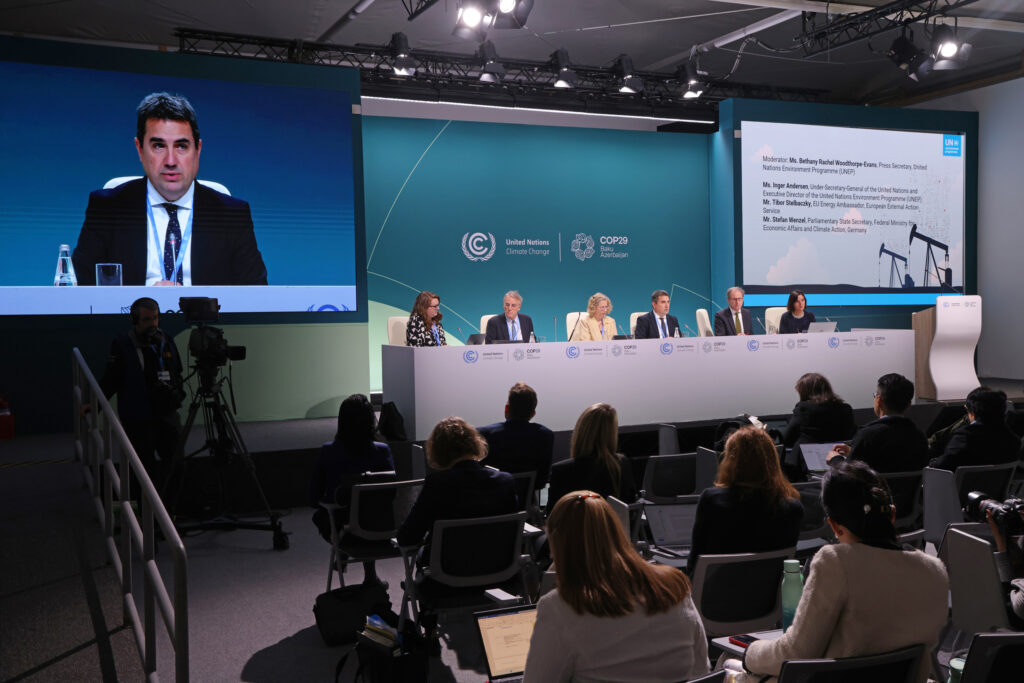What was billed as a “sprint to cut climate super pollutants” may soon slow to a jog.
Top climate diplomats from the U.S., China and host country Azerbaijan gathered at COP29, the United Nations Climate Conference in Baku, this week to host a summit on methane and other “non-CO2” greenhouse gases.
However, efforts to curb emissions of these climate super pollutants—greenhouse gases that on a pound-for-pound basis are far more effective at warming the planet than carbon dioxide—are likely to stall under President-elect Donald Trump. He has pledged to pull the U.S. out of the Paris climate agreement, and the oil industry is lobbying him to roll back emission regulations.
Methane, the primary component of natural gas, is the second leading driver of climate change after carbon dioxide. Quickly curbing its emissions from the oil and gas sector, agriculture and landfills is widely viewed as the most effective way to combat the near-term worsening of climate change over the next couple of decades, rather than centuries.
Emissions of methane, along with other non-CO2 greenhouse gases, including nitrous oxide and fluorinated gases, are responsible for as much as half of current warming.
“Global consensus on the need to tackle non-CO2 greenhouse gases is stronger than ever,” U.S. climate envoy John Podesta said at the methane and non-CO2 summit on Tuesday.
Podesta noted that 158 countries have now endorsed the Global Methane Pledge, a voluntary agreement to curb methane emissions launched by the U.S. and the European Commission in 2021.
Regulations enacted by the EPA last year are projected to reduce methane emissions from the oil and gas industry by 80 percent.
On Tuesday, the U.S. also finalized an oil and gas Waste Emissions Charge that places a fee on large emitters of methane, oil and gas facilities whose emissions exceed 25,000 metric tons of carbon dioxide equivalent per year. Excessive emissions will initially be charged $900 per metric ton of methane in 2024, increasing to $1,500 per metric ton in 2026. The fee was imposed by the U.S. Environmental Protection Agency and first applies to emissions that occur in the 2024 calendar year.
“The cost of methane abatement technology will continue to go down, and the availability of these solutions will continue to go up—this progress cannot be stopped,” Podesta said.
However, the American Exploration and Production Council, a group of 30 mostly independent oil and gas producers, is working to roll back the methane fee and other climate rules, according to internal documents obtained by The Washington Post.
Executives of companies represented by the industry group were among the oil and gas industry leaders aggressively courted for campaign funding by Trump earlier this year.
The American Petroleum Institute, an industry group representing a wider swath of the oil and gas industry, released its own wish list for the Trump administration on Tuesday that included a repeal of the methane fee.
This comes as disasters supersized by climate change keep mounting, killing people and destroying property. Greenhouse gases have already begun setting off dangerous feedback loops that threaten to make the crisis far worse, scientists warn. Climate advocates said the world—especially a top emitter like the U.S.—can’t afford to pump the breaks on efforts to reduce methane pollution.
“The only way to slow warming fast enough to prevent self-amplifying feedbacks from pushing the planet past tipping points is to cut methane and other super climate pollutants,” said Durwood Zaelke, president of the Institute for Governance and Sustainable Development, a climate advocacy organization based in Washington.
Rather than rolling back regulations, Zaelke said it’s time for a binding global agreement on methane.
Former U.S. Vice President Al Gore, a co-founder of Climate TRACE, a nonprofit organization that tracks greenhouse gas emissions, agreed.
“In the year after the methane pledge was finalized, global methane emissions went up 1.8 percent,” Gore said on Thursday as the organization released its latest inventory of emissions data. “Maybe we should start just by actualizing the methane pledge and getting the countries that have agreed to it to live up to what they agreed to do.”
Speaking at the methane and non-CO2 summit, Liu Zhenmin, China’s special envoy for climate change, said his country is working to improve monitoring and reduce methane emissions, particularly from coal mines.
China, the world’s largest methane emitter, released a national methane emissions control action plan in November of last year. However, the plan did not set targets on methane emission reductions.
China has since committed to including methane and other non-CO2 greenhouse gases in its emission reduction targets under the Paris climate agreement, due in February.
China could reduce methane emissions equivalent to 660 million metric tons of carbon dioxide per year by 2030 at little cost, according to a study published Nov. 8 in the journal Nature Communications. That’s like closing 170 coal-fired power plants.
Gore said he was optimistic China and other countries would continue to reduce emissions regardless of what happens in the U.S., due in part to the low cost of renewable energy.
“Market forces are giving us a tailwind in our efforts to solve the climate crisis, but it’s also true that governments have to do a much better job of organizing and pursuing the policy changes that are needed,” he said. “We’re in real danger.”
About This Story
Perhaps you noticed: This story, like all the news we publish, is free to read. That’s because Inside Climate News is a 501c3 nonprofit organization. We do not charge a subscription fee, lock our news behind a paywall, or clutter our website with ads. We make our news on climate and the environment freely available to you and anyone who wants it.
That’s not all. We also share our news for free with scores of other media organizations around the country. Many of them can’t afford to do environmental journalism of their own. We’ve built bureaus from coast to coast to report local stories, collaborate with local newsrooms and co-publish articles so that this vital work is shared as widely as possible.
Two of us launched ICN in 2007. Six years later we earned a Pulitzer Prize for National Reporting, and now we run the oldest and largest dedicated climate newsroom in the nation. We tell the story in all its complexity. We hold polluters accountable. We expose environmental injustice. We debunk misinformation. We scrutinize solutions and inspire action.
Donations from readers like you fund every aspect of what we do. If you don’t already, will you support our ongoing work, our reporting on the biggest crisis facing our planet, and help us reach even more readers in more places?
Please take a moment to make a tax-deductible donation. Every one of them makes a difference.
Thank you,



